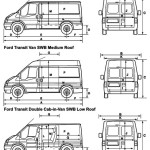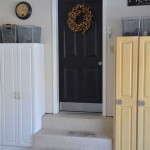How To Install An Interior Door That Is Not Prehung
Installing an interior door that is not prehung requires careful planning and execution. Unlike prehung doors, which come already fitted within a frame, a non-prehung door needs to be precisely aligned and secured within an existing or newly built frame. This process demands accuracy and attention to detail to ensure proper functionality and aesthetics. This article outlines the necessary steps for successfully installing a non-prehung interior door.
Key Point 1: Preparing the Door Frame
The preparation of the door frame is crucial for a successful installation. The frame must be square, plumb, and the correct size for the door. Any discrepancies in the frame will translate into problems with the door's operation, potentially leading to issues with closing, latching, or even rubbing against the frame.
First, inspect the existing door frame for any damage or irregularities. Look for cracks, warping, or rot, especially in older homes. If damage is present, repairs must be made before proceeding. Small cracks can be filled with wood filler, while more significant damage may require replacing sections of the frame. Pay close attention to the condition of the jambs (the vertical sides of the frame) and the head jamb (the top horizontal piece).
Next, verify the squareness of the frame using a carpenter's square. Place the square in each corner of the frame. If the frame is perfectly square, the square should fit snugly against both sides of the corner. If not, adjustments will be necessary. A common technique is to use shims to correct minor out-of-square conditions. Place shims behind the jambs at the top and bottom until the frame is square. Secure the shims with construction adhesive.
Check for plumbness by using a level. Place the level against the jambs to ensure they are perfectly vertical. Adjust with shims as needed until the jambs are plumb. Again, secure the shims with construction adhesive.
The size of the door opening is also critical. Measure the width and height of the opening in several places to ensure consistency. The door should have approximately a 1/8-inch gap on all sides (top, bottom, and both sides) to allow for smooth operation and prevent binding. If the opening is too small, the frame can be widened using a chisel or router. If the opening is too large, shims can be used to bring the frame in.
After making any adjustments, recheck the squareness, plumbness, and size of the opening. Ensure that all shims are securely in place. This meticulous preparation will greatly simplify the subsequent steps of the installation process.
Key Point 2: Fitting and Hanging the Door
Once the frame is properly prepared, the next step involves fitting and hanging the door. This process requires precise measurements and careful execution to ensure the door swings freely and aligns correctly with the frame.
Begin by measuring the door itself. Note the exact height and width. Compare these measurements to the opening size within the frame. As mentioned earlier, a 1/8-inch gap should be maintained on all sides. If the door is too large, it will need to be trimmed. Use a planer or a circular saw with a fine-tooth blade to carefully remove excess material. Work slowly and in small increments to avoid removing too much material.
Once the door is sized correctly, determine the hinge placement. Standard practice dictates that hinges are typically placed 7 inches from the top and 11 inches from the bottom of the door. A third hinge may be required for taller or heavier doors, typically placed centered between the top and bottom hinges. Mark the hinge locations on both the door and the jamb.
Using a utility knife, score around the marked hinge locations on both the door and the jamb. This scoring will help prevent splintering when chiseling out the mortises. Use a sharp chisel and a hammer to carefully remove the wood within the marked area to create a mortise for the hinge. The depth of the mortise should match the thickness of the hinge leaf, allowing the hinge to sit flush with the surface of the door and jamb.
After the mortises are cut, attach the hinges to the door using screws. Ensure the screws are the correct size and length to prevent stripping the wood. Pre-drilling pilot holes can help prevent the wood from splitting. Once the hinges are securely attached to the door, position the door within the frame and align the hinges with the mortises in the jamb.
Secure the hinge leaves to the jamb using screws. Start with the top hinge and then the bottom hinge to ensure proper alignment. Once these two hinges are in place, install the screws in the remaining hinge. After all the hinges are secured, test the door's swing. It should swing freely and without binding. If there is any binding, identify the cause and make necessary adjustments, such as adding shims behind the hinges.
This stage of the installation process necessitates meticulous attention to detail. Accurate measurements, precise mortise cuts, and careful hinge placement are essential for a properly functioning door.
Key Point 3: Installing the Door Hardware
Installing the door hardware, including the doorknob, latch, and strike plate, is the final step in the installation process. This step is critical for ensuring the door latches securely and operates smoothly.
Begin by marking the location for the doorknob. The standard height for a doorknob is typically 36 inches from the floor. Use a hole saw of the appropriate size to drill a hole through the door for the doorknob. The hole should be centered on the marked location and drilled straight through the door.
Next, install the latch mechanism into the edge of the door. Most latch mechanisms require a mortise to be cut into the edge of the door. Use a chisel to carefully remove the wood, creating a mortise that matches the shape and size of the latch plate. Slide the latch mechanism into the mortise and secure it with screws.
Close the door and mark the location for the strike plate on the door jamb. The strike plate is the metal plate that the latch bolt engages with when the door is closed. To accurately mark the location, apply a small amount of lipstick or grease to the end of the latch bolt. Close the door gently, allowing the latch bolt to make contact with the jamb. The lipstick or grease will transfer to the jamb, indicating the exact location for the strike plate.
Use a chisel to create a mortise in the jamb for the strike plate. The mortise should be deep enough to allow the strike plate to sit flush with the surface of the jamb. Attach the strike plate to the jamb using screws. Ensure the strike plate is aligned correctly with the latch bolt to allow for smooth and secure latching.
Install the doorknob hardware according to the manufacturer's instructions. This typically involves inserting the spindle through the door and attaching the doorknob handles on either side. Tighten the set screws to secure the doorknob in place.
Test the door's operation by opening and closing it several times. Ensure the door latches securely and that the doorknob operates smoothly. If there are any issues with the latching mechanism, adjust the strike plate as needed. Small adjustments can be made by loosening the screws and shifting the strike plate slightly.
Following these steps carefully will ensure a well-functioning and aesthetically pleasing interior door installation. A properly installed door should swing freely, latch securely, and complement the overall design of the room.

How To Hang An Interior Door Tips And Guidelines Howstuffworks

How To Hang A Door That Is Not Prehung

How To Install An Interior Door A Erfly House

How To Hang A Door That Is Not Prehung

How To Install An Interior Door Without A Frame

How To Upgrade Your Doors Without Removing The Jamb Or Trim Slab Door Install

How To Install An Interior Door A Erfly House

How To Install An Interior Door The Home Depot

Can I Hang A New Door In An Existing Frame Express Doors Direct Blog

Interior Door Installation Canadian Woodworking
Related Posts








